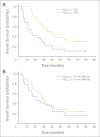Cardiopulmonary function and age-related decline across the breast cancer survivorship continuum
- PMID: 22614980
- PMCID: PMC3397786
- DOI: 10.1200/JCO.2011.39.9014
Cardiopulmonary function and age-related decline across the breast cancer survivorship continuum
Abstract
Purpose: To evaluate cardiopulmonary function (as measured by peak oxygen consumption [VO(2peak)]) across the breast cancer continuum and its prognostic significance in women with metastatic disease.
Patients and methods: Patients with breast cancer representing four cross-sectional cohorts--that is, (1) before, (2) during, and (3) after adjuvant therapy for nonmetastatic disease, and (4) during therapy in metastatic disease--were studied. A cardiopulmonary exercise test (CPET) with expired gas analysis was used to assess VO(2peak). A Cox proportional hazards model was used to estimate the risk of death according to VO(2peak) category (< 15.4 v ≥ 15.4 mL · kg(-1) · min(-1)) with adjustment for clinical factors.
Results: A total of 248 women (age, 55 ± 8 years) completed a CPET. Mean VO(2peak) was 17.8 ± a standard deviation of 4.3 mL · kg(-1) · min(-1), the equivalent of 27% ± 17% below age-matched healthy sedentary women. For the entire cohort, 32% had a VO(2peak) less than 15.4 mL · kg(-1) · min(-1)--the VO(2peak) required for functional independence. VO(2peak) was significantly different across breast cancer cohorts for relative (mL · kg(-1) · min(-1)) and absolute (L · min(-1)) VO(2peak) (P = .017 and P < .001, respectively); VO(2peak) was lowest in women with metastatic disease. In patients with metastatic disease (n = 52), compared with patients achieving a VO(2peak) ≤ 1.09 L · min(-1), the adjusted hazard ratio for death was 0.32 (95% CI, 0.16 to 0.67, P = .002) for a VO(2peak) more than 1.09 L · min(-1).
Conclusion: Patients with breast cancer have marked impairment in VO(2peak) across the entire survivorship continuum. VO(2peak) may be an independent predictor of survival in metastatic disease.
Conflict of interest statement
Authors' disclosures of potential conflicts of interest and author contributions are found at the end of this article.
Figures



References
-
- Shapiro CL, Recht A. Side effects of adjuvant treatment of breast cancer. N Engl J Med. 2001;344:1997–2008. - PubMed
-
- Jones LW, Haykowsky MJ, Swartz JJ, et al. Early breast cancer therapy and cardiovascular injury. J Am Coll Cardiol. 2007;50:1435–1441. - PubMed
-
- Ewer MS, Lenihan DJ. Left ventricular ejection fraction and cardiotoxicity: Is our ear really to the ground? J Clin Oncol. 2008;26:1201–1203. - PubMed
-
- Jones LW, Eves ND, Haykowsky M, et al. Exercise intolerance in cancer and the role of exercise therapy to reverse dysfunction. Lancet Oncol. 2009;10:598–605. - PubMed
Publication types
MeSH terms
Grants and funding
LinkOut - more resources
Full Text Sources
Medical
Miscellaneous

